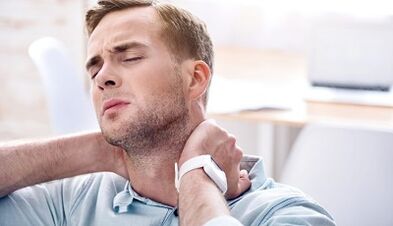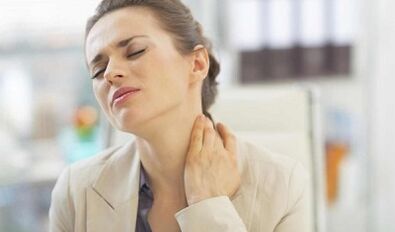
Pain in the neck muscles can be related to various deviations.The fundamental cause can be both diseases of the musculoskeletal system and disruption of the work of the internal organs.
Pain syndrome relieves the problem: Diagnosed pathologies should be adjusted according to the adequate course of treatment.
Possible causes of neck pain
It is known for many reasons that relieve pain in the neck.The source can be diseases of the musculoskeletal system, decreased blood circulation in the neck, vascular disease.
One of the most common causes of pain is the pathology of the spine.The neck can also be damaged by the pathologies of the internal organs, infectious and viral processes.
Osteochondrosis
With osteochondrosis of the cervical spine, the neck aches due to skin discs and deformation.These disorders cause microconstricts on the vertebrates, which provokes osteophyte growth and hernia.Abnormal formations have a traumatic effect on the surrounding tissues and nerve endings, which causes the inflammatory process.
With osteochondrosis of the cervical spine, the pain syndrome is localized in the back of the neck.When the neck turns, severe discomfort and crunching are added to the pain.
The pain is intense in turn or sudden movements, cough or sneezing.As osteochondrosis develops, the pain spreads and reaches the shoulder and forearm areas.
Particularly severe pain occurs in the morning.There is also the hardness of the movements, the patient literally fails to move to his side.
Gradually, the pain becomes less pronounced, transforming from acute to stupid.
The sharp periods of pain in the cervical spine in osteochondrosis are compared to shock - they are such shooting and piercing.
Also, along with the specified disease, the following symptoms are noted:
- Hand weakness;
- Headache;
- Bleaching;
- Dizziness;
- Noise and call in the ears;
- A sense of disorientation;
- Insomnia;
- Emotional instability.
The neck of myosite
Cervical myositis is inflammation of the neck muscles.The main symptom of this deviation is intense pain that can be reduced or increased.The patient cannot turn his head, tilted forward or backwards.
Most often, myositis pain extends only to one side of the neck, but sometimes both can affect both at the same time.Pain is characterized by irradiation on the upper body.
Also, with the inflammatory process of the neck muscles, the gravity of the neck is felt, forms of swelling in the vertebrates.Pains may occur in the head, which gives the head or the back of the temple.There are also difficulties in chewing and swallowing food.
As the abnormal process develops, the temperature rises, coughing, attacks attacks.
The cervical spinal column hernia
This pathology is the result of the progression of osteochondrosis.This is very dangerous: there is a large number of spinal cord nerve endings in the cervical region.In addition, there are centers that are responsible for oxygen flow in the lungs.That is why the hernia is headache attacks, dizziness, robbery.

With strong polishing of the hernia, a person can rob.
If the hernia struck the discs between the first and fourth vertebrates in the space, then the pains are short -term, it is unexpected.After the fourth spine with the displacement of the discs, the pain is localized in the shoulder area, after the sixth - from the shoulder joint to the upper extremity fingers.
In addition to pain in the patient's neck, the patient is observed:
- Feeling weak in the hands, their numbness;
- Reduction of head mobility;
- Migraine;
- Dizziness;
- Visual severity disorder.
As the disease progresses, the coordination of the movements is disturbed, the person becomes less stable.
Spondylarthrosis
With spondylo arthrosis of the cervical spine, inflammation of the price joints is observed, causing their structure.In this case, the experience of the joints has increased load and damaged, causing osteophytes to produce bones - the increase in pressure on the vessels and nerve roots.
With spondylo arthrosis of the neck, there are brief pains in this area that are given their hands, beard, and shoulder blades.Neck sensitivity also decreases, its mobility is limited after sleep.In addition, patients note the dizziness and flickering of flies in front of the eyes.
The nature of pain depends on the stage of spondylo arthrosis:
- First of all, this is virtually non -existent: only prolonged loads are discomfort.
- In the second stage, severe pain is observed in the morning.
- The third person feels pain.
- In the fourth stage, the mobility of the affected joints is impaired and over time, provided that there is no adequate treatment, they are completely immobilized.
In the development of an abnormal process, additional symptoms appear: noise in the ears, the cervical and shoulder zones, changes in blood pressure levels, and disruption of movement coordination.
Bechterev's disease (ankylous spondylitis)
Bechterev's disease is a chronic inflammatory process of the spine that deals with joints and ligament.With this disease, the inflammatory process initially affects the site of the bones of the zirum and Iliak, then slowly spreading to the upper part, revealing degenerative changes in the entire spinal column.
Sometimes the process of developing an abnormal process begins with the neck, in particular the cervical sciatica.In this case, the patient feels dramatically falling from the neck to the hands.
Ankylotic spondylitis, spinal column firmness, restriction of chest mobility, and loss of flexibility with the spine.Spinal column curve in the chest and lumbar region.In this case, the "speaker posture" is observed.
The disease progresses slowly, so it remains unnoticed for a long time.
Cervical tuberculosis
Spinal column tuberculosis can affect any of its departments, and the cervix is subject to a small degree of this disease.However, such pathology is still found (in 5% of cases).
In this case the symptoms are:
- Severe, constant pain in the neck muscles;
- Swelling of the affected area, constantly increasing in size;
- Sore throat;
- Cough;
- Difficult to swallow.
Pain syndrome with cervical spine is very strong.The patient tries not to make the movements of his head as it causes him to suffer a great deal.In this case, absolutely all muscles hurt, including deep muscle layers.
Tumor neoplasms of the cervical section
Cervical spine tumors are rarely found, but metastases from tumors often penetrate this area, located in the kidneys, in the mammary glands.
With the tumors of the neck, the patient experiences pain, which becomes more intense as the abnormal process develops.

In addition, symptoms such as:
- Muscle weakness;
- Muscle cramps;
- Numbness;
- Headache;
- Dizziness;
- Difficulties with swallowing;
- Insomnia;
- Business states have been transformed;
- A pleasant sweat compartment.
Tumors that are localized to the neck affect the brain.This results in the appearance of neurological symptoms mentioned in this list.
Meningitis
Neck muscles often ache in the case of meningitis.It is an inflammatory process that affects the brain or spinal cord shells.In this case, the muscle fibers of the muscle fibers of the head are spasm.
With meningitis, a person feels boring on his neck, unable to get his back on his back.
Also, along with meningitis, such characteristics arise:
- Persistent headache in which there is a feeling of cranial box burst from the inside;
- Upper and lower extremity seizures;
- Hallucinations;
- Unapotivated aggression;
- Increased body temperature;
- Nausea and vomiting;
- Inability to perceive bright color;
- Disruption of consciousness.
Thyroid diseases
Thyroid dysfunctions affect the patient's general wells and cause an abundance of characteristic symptoms.
This part of the endocrine system is located in the throat area, so its inflammation or other nature of damage causes pain in the neck.A similar symptom is found in hyperthyroidism, hypothyroidism, thyroid, thyroid development.Pain is caused by an increase in gland measures as well as hormonal disorders in the body.
With these diseases, the pain is real regular and localized in the anterior part of the neck.Pain can be given to the occipital area, the area of the ears.A quarrel can be observed periodically.
Additional Symptoms:
- Feeling heat;
- Increased sweating;
- Heartbeat;
- Drowsiness.
Neuralgia
Cervical spine neuralgia is a disorder of the nerve root that is associated with a disruption of the intervertebral disc structure.

Cervical neuralgia is accompanied by such symptoms:
- Pain in the neck, which suddenly occurs when turning to the head, touching the site of the gastrointestinal nerve.At the initial stage of development of the pathology, the pain is localized at the lower part of the neck, in the posterior part and subsequently spreads to the eye area.The nature of the pain is a severe painful sensation that resembles an electric shock.
- Increased photosensitivity.
- Head skin pain.
- One -sided headache that is constant pain.
- Blood pressure.
- Heat, cold.
- Hands.
Neck pain can be caused by high emotional stress, increased physical effort.
Which doctor contacted?
The appearance of regular pain in the neck, which has a pronounced character and radiation in certain zones of the body, is a case of seeing a doctor.
First of all, you should visit a therapist who, after analyzing the main symptoms, determines which specialist requires a particular case.
Establishment of causes that cause pain in the neck as well as treatment of pathologies in which it occurs is involved in such specialized specialists:
- Neurologist.This specialist treats diseases that have caused cervical nerve or spinal cord injury.The neurologist is busy in cases where pain in the neck is accompanied by migraine, dizziness and seizures.
- Traumatologist.The doctor is busy in cases where the pain was caused by injuries.
- Spine.The specialist regulates the patient's condition-muscular system-intervertebral hernia, spondylitis.
- Orthopedic.Consult this physician with pathologies such as cartilage, scoliosis, osteoporosis.
- Osteopath.This specialist treats patients who experience degenerative changes in the joints and vertebrates.Osteopath is treated with osteochondrosis, involved in adjusting the patient's posture.
- Rheumatologist.The doctor is involved in the cases of muscle and bone tissue damage - rheumatism, arthritis.
In addition to these experts, a manual therapist, physiotherapist, a massageist may be required.
Diagnostic methods
With pain in the neck muscles, such diagnostic measures are prescribed:
- Anames Collection;
- Visual check;
- Check the sensitivity of the affected area as well as its mobility;
- Blood and urine tests;
- Cervical spine x -ray examination;
- MRI;
- CT;
- Electromyography.
Based on the results of the diagnosis, the specialist determines the cause of pain in the neck and determines adequate treatment.
What to do if the neck hurts: treatment approaches
A particular disease is treated according to a certain scheme.It all depends on the root cause of pain syndrome, but we can distinguish between the basic approaches to eliminate unpleasant sensations.
Drug therapy
Often, the pain in the neck becomes very intense.To suppress its severity, the patient is prescribed medications.In this case, the following medications are suitable:
- Anti -anti -tablets;
- Musorelaxants - painkillers that relieve spasms;
- Analgesics used to exacerbate diseases.
In diseases that cause pain in the neck and the processes of cartilage and bone tissue processes, chondroprotectors - medications that have a positive effect on its recovery processes, as well as anesthetic.
Also, patients with neck pain are shown medications that normalize metabolic processes in the affected tissues.
Physiotherapy

If the neck muscles hurt due to degenerative processes of the spine, such physiotherapeutic procedures are given:
- Diadinomotherapy- Impact on the affected areas with double current waves;
- Balneotherapy- measures associated with water procedures;
- Electrical therapy- Exposure to electrical current in affected areas;
- Magnetotherapy- Exposure to magnetic fields on cervical pain;
- Laser therapy- Laser impact.
Physiotherapeutic procedures are not performed in the event of a general serious condition of the patient, during the period of exacerbation of osteochondrosis, with mental disorders, decreased skin decrease at the site of the expected effect.
The listed auxiliary methods of treatment not only contribute to reducing the intensity of pain, but also enhances immunity, restores blood circulation to the affected areas, and reduces the severity of musculoskeletal disorders.
Massage
In case of pain, localized neck can also be included in the difficult therapy of massage procedure.They are performed by a specialist because the wrong approach can cause additional damage to bone and muscle structures.
Neck massage that relaxes muscles is performed in a sitting or lying condition.The effect is carried out on the muscles of the trapezoid that support the cervical vertebrates.
Initially, the specialist makes light stroke movements from top to bottom.After warming techniques, special processes are made.Next, spray the back surface of the neck, vibrating exposure.
The massage session takes 3 to 10 minutes.
Surgical intervention
Neck pain surgery may be necessary if there are such pathologies:
- Intervertebral disk hernia;
- Compression of spinal roots, or radiculopathy;
- Spinal cord compression, or myelopathy.
Cervical spine surgery is designed to remove spine sections, which has a traumatic effect on the spinal cord.
Currently, classic operations that require a long rehabilitation period will replace less invasive methods:
- Endoscopy in which the intervention is performed by puncture;
- Microsurgical operations that allow you to remove the hernia without damaging the tissues surrounding the spinal cord.
Folk remedies
In case of pain in the neck, you can try to calm it with the help of folk remedies.Most effective:
- Compressions with horseradish.The horseradish sheet should be rinsed with boiling water, hold it to a comfortable temperature, attach it to the neck.Wrap the scarf on top.You should use compresses before bed and leave it all night.If there is a strong burning sensation, you should remove the compresses and rinse your skin with warm water.
- Compress with Laurel Oil.10 drops of oil should be diluted with 1 liter of warm water.Pour the tissue into the liquid and attach to the neck for 20-30 minutes.
- Lubricate the affected area with honey.After applying it, you must firmly press the treated seat with your palms, then drain it sharply.Repeat until the honey is completely absorbed.
General recommendations
In diseases that cause severe pain in the cervical spine, you should pay attention to the following recommendations:
- It is necessary to properly posing both while sitting and walking.
- When pain in the cervical region occurs during physical exercise, it is worth stopping their performance, muscle relaxation.In the future, the quality of loading should be considered to be subject to the neck area.
- It is necessary to regularly devote time to physical effort, at least not so intense.For the health of the spine, swimming, yoga is useful.
- It is advisable to give preference to backpacks and not the bag: it gives a uniform load on the left and right parts of the body.
- It is useful to take a contrasting shower.Temperature alternation has a positive effect on blood circulation, does not give blood and lymph stagnate.
The same recommendations can be used as a prevention.
Neck muscles can damage due to various pathologies of the spinal column, somewhat less painful syndrome due to pathologies of the internal organs.The treatment regimen depends on the reason for the diagnosis by the physician, after a comprehensive examination.


























